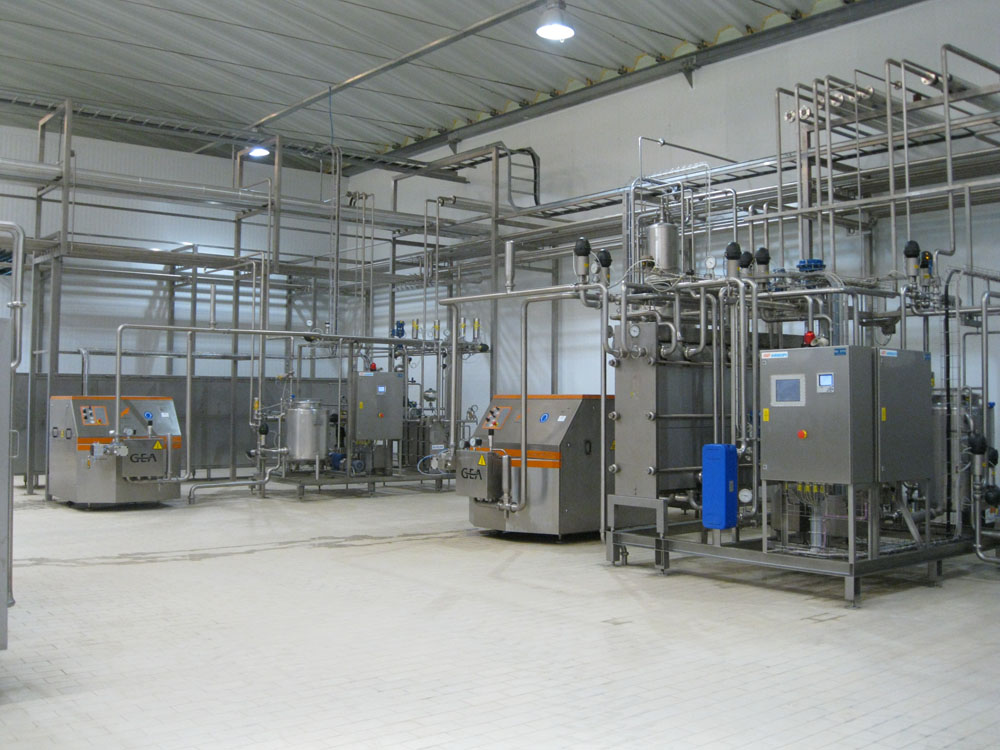Homogenization is a process of reducing the size of particles in a substance to create a uniform and consistent product. This process is commonly used in the food and dairy industry to create products such as milk, ice cream, and yogurt.
The process of homogenization has several benefits. It helps to prevent the separation of cream in milk, which can occur due to the differences in the density of the fat particles. Homogenization also improves the texture and consistency of products such as ice cream and yogurt by reducing the size of the particles and creating a smoother product.
Homogenization also has some disadvantages. The process can cause changes in the flavor and nutritional content of the substance, and can also make it more difficult for the body to digest. Some people also believe that homogenization can contribute to the development of certain health problems, although there is no conclusive evidence to support this claim.
Despite its drawbacks, homogenization is a widely used process in the food and dairy industry, and has helped to create many of the products that we enjoy today.

Application areas of homogenizers
Equipment for homogenization is used in various fields, including chemical, food, pharmaceutical, brewing, research, electronic and other industries.
- In the chemical industry homogenizers are used to obtain the necessary product properties as a result of various reactions, including the synthesis of new substances, conversion of raw materials and semi-finished products into finished products.
- In the food industry homogenizers are used to prepare soups, ketchups, mayonnaise, yogurt, chocolate drinks and other products. They can also be used to process fruits and vegetables into purees, juices and cans. The main function of a homogenizer pump is to form homogeneous mixtures (emulsions and suspensions) for industrial plants.
- In the perfume and cosmetic industry for the creation of perfumes, toilet water, creams, shampoos, balsams, gels, lotions, toothpastes, etc.
- In the pharmaceutical industry for the production of ointments, syrups, solutions, phytoextracts, etc.
- In the production of household chemicals (dishwashing detergents, glues, etc.).
- In the production of paint and varnish materials.
Application of homogenizers in milk production

In the dairy industry high pressure homogenizers are used to convert milk to a homogeneous state, i.e. to vary its properties and composition. This can be necessary to produce dairy products with the desired properties.
A homogenizer is used to treat milk to make it more stable and resistant to bacterial variability. It works by feeding milk into a heat-processing chamber where it is heated to a high temperature and maintained at that level for a period of time. This kills bacteria that can lead to changes in the taste and flavor of milk, as well as improving the shelf life of the product.
Homogenizers are used in the dairy industry to produce a wide range of dairy products such as cheese, yogurt, cottage cheese and cream. They can also be used to produce pasteurized milk that keeps its properties for a long time.
Types of homogenizers
Plunger homogenizer
A plunger homogenizer is a mechanical device used to break down solids and dissolve or dilute substances in a liquid. It usually consists of a cylindrical chamber with a plunger that rotates inside it. A plunger homogenizer can be used to produce a homogeneous mixture of different substances, e.g. for the production of pharmaceuticals, food products, etc. It can also be used to grind solid materials such as adhesives, plastics, etc.
The plunger homogenizer works by rotating a plunger that moves up and down in a cylindrical chamber.
Oil homogenizer
A homogenizer is a device that is used to process the fats in oil in order to homogenize them. This means that a homogenizer helps to mix the heterogeneous components in the fat, such as fatty acids, physical inconspicuous particles and air, to make it more homogeneous.
Homogenizers are usually used in the production of food products such as margarine, butter and other cream to make their texture more homogeneous and easy to use.
To obtain a homogeneous mass of butter or soft cheeses, a homogenizer plasticizer is used. During homogenization the liquid is distributed evenly throughout the entire volume of the product. Due to improved properties the shelf life of butter increases, it is easier to defrost.
Ultrasonic homogenizers
Ultrasonic homogenizer is a device that uses ultrasonic waves to process fats in order to bring them into a homogeneous state. Ultrasonic waves are able to break down small particles and stir them into the fat, making it more homogeneous.
Ultrasonic homogenizers are commonly used in the production of food products such as margarine, butter and cream to make their texture more homogeneous and easy to use. They can also be used in the production of detergents to make them more efficient and easy to use.
Ultrasonic homogenizers are usually faster than mechanical homogenizers.
How to choose the right homogenizer for production
In order to choose the right homogenizer, the following factors must be taken into account:
- Type of product: there are many types of homogenizers designed for different types of substances. For example, there are homogenizers for oil, cream, etc.
- Requirements for homogenization conditions: there are different types of homogenizers that can provide different working conditions and allow you to get the expected result.
- The size of the homogenizer. It must be large enough to hold the right amount of raw material.
- Type of homogenizer. Choose the type that best suits your requirements.
- The capacity of the homogenizer. It should be sufficient to achieve the right level of homogenization in the required period.
- Temperature setting. Make sure that the homogenizer has the right temperature range and that it can work at the right temperatures.
- Degree of automation. If you plan to use the device in production, then mechanical homogenizers or mixers are unlikely to be suitable for you.
Requirements to the homogenization process
The considered method of dairy processing can not be considered in isolation from the associated technological processes of product preparation for final production. In particular, milk homogenization is a procedure that can be associated with storage, transportation and subsequent pasteurization operations. Accordingly, there are universal general requirements for the processing of milk, which relate more to sanitary and hygienic standards, but there are also special rules for performing homogenization. Among them, the following can be noted:
- Prior to processing, the raw milk undergoes initial filtration and cooling.
- Milk temperature should range from 4 to 6 ° C. The specific mode will determine the allowable storage time before and after processing – usually no more than 6 h.
- The average pressure during milk homogenization is 10 MPa. At the same time to normalize the heterophase structure it may be necessary to increase the phase separation by 500 thousand m2 for each ton of raw milk.
- Homogenization is performed before pasteurization. There may be exceptions if the operation is performed at 60 °C. This mode is usually used for skim milk and cream production, but even in this technological scheme after homogenization additional pasteurization will follow.
The benefits of homogenization for milk
The use of a homogenizer affects the quality of milk:
- Increases the viscosity of milk, thereby improving milk quality.
- Ensures an even distribution of fat in the milk. Thus, it prevents the formation of a layer of fat.
- As the fat particles in the milk are separated into smaller pieces, the surface area increases and makes the milk tastier.
- After homogenization, milk is whiter because it reflects light better.
- Makes milk easier to digest.

Quality assessment
Factors such as: pressure and temperature of the raw material to be processed influence the goodness and usefulness of the process. The first of these directly affects the degree of crushing of fat droplets, and the second – the homogeneity of the product and ease of processing for the machine.
Under pressure, a number of manipulations take place inside the homogenizer. As the piston moves to the left side, the milk enters the cylinder through a valve. When the slide moves back, the raw material enters the booster chamber, where the most powerful pressure is concentrated. At the same time, the other half of the raw milk flows through an annular valve hole into the booster tube. The pressure is controlled by a special screw. Clamped in the right position, it contributes to increasing the pressure on the damper. On the outside there is a sensor with a monitor through which the control.
To achieve the most effective result of the homogenization procedure, it is recommended to preheat the milk to 65 degrees. In this condition peptide bonds are broken much easier, which contributes to the even crushing of fat droplets.
Also the efficiency of the procedure is influenced by such factors as the speed of raw material movement in the homogenizing head, peculiarities and technology of apparatus assembly, natural characteristics of fat membranes, the level of acidity in the mass and most importantly the correctness of the procedure and compliance with all the rules at every stage of processing.
There is a basic criterion by which you can reliably determine how effective homogenization was. It is called “working pressure”, and represents the difference in pressure before and after its passage through the valve in the grinding head. The point of the procedure is to achieve a minimum of milk settling and separation of sub-products such as cream from it.
Efficiency is determined by the following factor: the longer the products will stand after this type of processing, the better the procedure is performed. If, however, the separation of fat occurred in a fairly short period of time – this indicates that during the next operation it is necessary to increase the pressure inside the homogenizer even more.
Conclusion
For all the positive effects of homogenization, many experts are critical of it because of the production of harmful enzymes. However, at the moment, there are no reliable studies that reveal a significant difference for human health between the natural and processed dairy products in this way. Moreover, today homogenization of milk is a complex of production processes that have become a necessity in the food industry. This method of mechanical processing is used not only in relation to fresh milk, but also in the recovery of dried raw milk by regulating the degree of fat content. Another thing is that in each case modifying chemical additives are also used, the presence of which in principle reduces the value of the product.
Dear food manufacturers! We present a cam pump for transporting liquid and viscous products.
Our pump is equipped with a patented soft cam pumping system that carefully and without damage pumps the most delicate products – yoghurts, juices, purees, sauces and much more.
